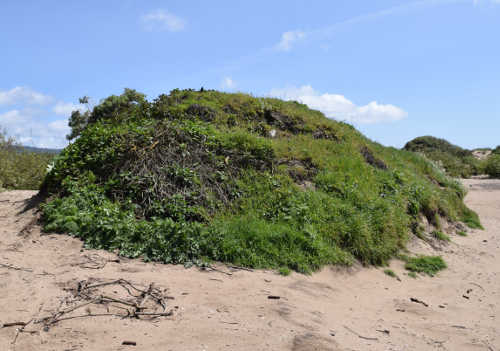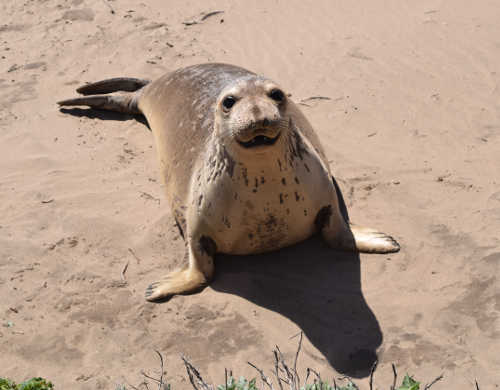Before I could respond, I’m interrupted by a loud flapping, gurgling sound emanating from what I had thought was a piece of driftwood to my left.
“Scare you?” Hylkema asks, as I hop quickly away. The piece of “driftwood” sprouts a large pair of brown eyes and wiggles a pendulous nose at us. We must have woken it up.
After working for decades as the district archaeologist for this and several other state parks, Hylkema takes a pretty lackadaisical approach to the resident elephant seals that lie about the beach at Point Año Nuevo.
Although the animals are not the reason for my own visit to the state park this day, I know that I am in the minority.
Each year some 65 to 70 thousand visitors hike the 3 miles of sand dunes from the parking lot off Highway 1 for the sole purpose of getting a close view of these loud, blubbery creatures. Staring at the seal that interrupted our afternoon hike through the dunes, I can see why.
Elephant seals are the largest seals in the world, the average male weighing in at around two to three tons.
Northern elephant seals, like the ones at Point Año Nuevo, are slightly smaller than their southern counterparts. Any difference in size between the two, however, is pretty negligible when you see one in person. After all, what’s the difference between two and three tons when its lying on the beach not ten yards from you?
Of course, it isn’t their size that inspires their name, but their peculiar snouts. The nose of the one several yards away from Hylkema and I wiggles slightly each time she exhales.
“Seeing one in person is an amazing experience,” Mike Merritt tells me over the phone a week before my trip to the park. Merritt is an interpreter with the park and the chief administrator of their docent program.
According to Merritt, Point Año Nuevo is a unique place in all of California. “For one thing, this park is the only place in the state where you can walk among elephant seals. At Piedras Blancas and Point Reyes to our north, visitors can only view them from a distance. Here, it’s almost like a safari experience, especially during our guided walks.”
The park only offers those guided walks during the peak breeding season of December through March when the beaches are full of large male seals competing for the affection of the females.
The docents who lead the guided tours are trained to not only answer any question about the seals, but also to steer groups of people through the quagmire of animals.
“But because they are guided, and because we have so many people coming to the park during those months, the guided tours have to keep to a tight schedule,” Merritt explains. For a more relaxed, do-it-yourself experience, he suggests visiting the park during the offseason. During the summer months, the seals usually confine themselves to the beach, so visitors can roam among the dunes safely while still getting rather close for good photographs.
“People think the seals are only there during the winter, but they are also on the beach in the summer, when they come ashore for their catastrophic molt.” My silence at the other end of the line must have tipped Merritt off to my confusion. “Don’t worry, ‘catastrophic molt’ is just the technical phrase, nothing explodes or anything.”
Standing on the beach in person, I find it hard to believe Merritt – it certainly looks like something exploded. It’s April and I just missed the breeding season.
Even so, I see evidence of the last four months strewn along the sand. Bits of fish lie here and there half sticking out of the ground and deep ruts where the behemoths dragged themselves from the sea to the breeding grounds still crisscross the sand.
Every now and then I come across a sand dune collapsing into what can only be described as a crater. These massive divots are where the seals like to wallow – much like pigs do in mud.
Hylkema’s comparison of the animals to pigs is starting to grow on me.
I can’t help but recall something Merritt had said to me before I came. “When people come here, they come for the elephant seals, but they end up finding a lot of other things to see.” I’m doing things backwards. I came for “the other things” and am finding myself engrossed with the seals.
The medium-size female seal who first startled Hylkema and I gives me another flappy grunt and drops her head back to the sand. After the sow resumes her nap, we move on with our hike, looking for the true object of my visit: the sand dunes.
Or rather, not dunes at all. Some of the piles of sand amid the actual dunes are middens – heaps of refuse formed after centuries of Native Americans processing fish, shells and stone.

This stretch of central California coast was the ancestral lands of the Quiroste Indians. The Quiroste were just one of 50 polities that made up the Ohlone Indians, a language group that stretched as far north as San Francisco to as far south as Santa Cruz.
“Of the 50 tribal communities of the Ohlone, the Quiroste were by far the most powerful,” Hylkema explains to me as we stand at the base of one of the middens.
A local source of chert for tool making and an abundant supply of olivella shells for beaded money made the Quiroste a trading powerhouse for several millennia. How long they lived here is still being fleshed out by archaeological exploration.
Studying the middens like those found among the dunes at Point Año Nuevo is one way archaeologists are able to learn more about the Quiroste. After all, what better way to learn about a people than by the refuse they leave behind?
Chips of processed chert and small pieces of shell lie about the mound that Hylkema and I find ourselves in front of. The Quiroste lived farther inland but would venture out to the beach to collect and process food, stone tools and other items.
“They would sit here near this midden and spend hours processing the material and over decades and centuries the bits of shell and whatnot would pile high,” Hylkema says.
Analyzing the number and diversity of material in these middens allows archaeologists to determine the types of food the Quiroste harvested from the ocean and periods of high production and low production of their tools and shell money.
As I’m standing there contemplating the centuries of history in front of us, Hylkema grabs my attention. He nudges my shoulder and points to a football size flat stone lying nearby.
“See that?” he asks. “In the many years that I’ve been doing this, I keep coming across stones like those associated with middens in this area. I have no evidence to corroborate this, but I like to think of them as butt stones.”
The wind has picked up and I obviously can’t hear him clearly.
“Seriously, think about it. If you had to spend hours and hours working here on the beach, wouldn’t you want to make a seat for yourself?” Nope, I heard him correctly. And, as odd as it sounds at first, Hylkema’s theory makes sense in a very human way. Ethnographic sources also tell us that the Quiroste wore few if any clothes to speak of, making a stone seat far preferable over the abrasive sand.
I have the feeling I’m being made the butt of a joke.
Before I can say so, a flabby bellow announces the presence of yet another elephant seal, this one a baby.
I don’t jump quite as high as the first time.
“It’s certainly never boring out here,” Hylkema says with a grin.
If you visit
The park is open from 8:30 a.m. to sunset, but the preserve opens at 9 a.m. and closes at 5 p.m. – so to visit the seals you need to arrive at the front gate to get the free permit by 3:30 in the afternoon.
If you go for the seals know that it is a 3-mile hike from the parking lot to the beach and dunes where the animals are. The hike is mildly strenuous so be prepared and wear appropriate footwear.
Once at the beach, docents are available to answer any questions you might have and to direct you to where you can and cannot walk.
There are a lot of other things to see at the park. In addition the preserve where the seals and dunes are, there is a very informative Marine Education Center where visitors can learn more about the natural habitat around them.
If education is not necessarily your thing, there is also an excellent public beach just a quarter mile from the parking lot of the park. Usually a lot less crowded than other nearby beaches, this one is a favorite of local surfers.
Antone Pierucci is the former curator of the Lake County Museum in Lake County, Calif., and a freelance writer whose work has been featured in such magazines as Archaeology and Wild West as well as regional California newspapers.


 How to resolve AdBlock issue?
How to resolve AdBlock issue? 




